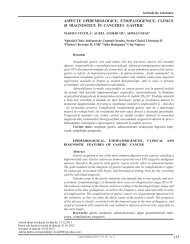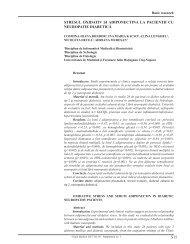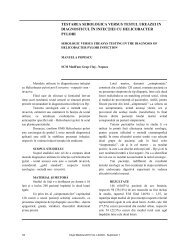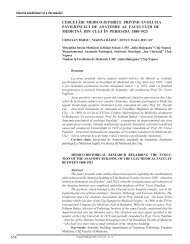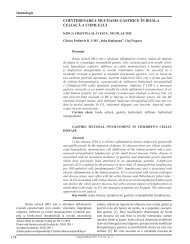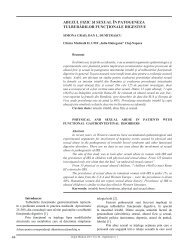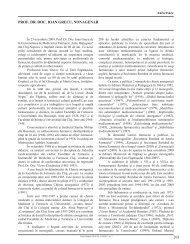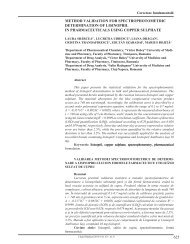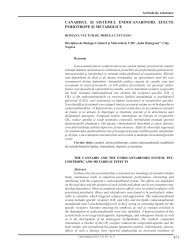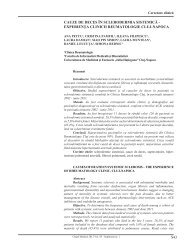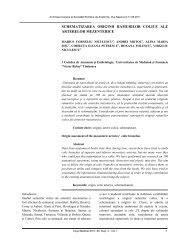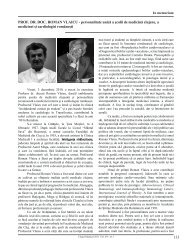RevistÄ de MedicinÄ Åi Farmacie - Clujul Medical - Iuliu HaÅ£ieganu
RevistÄ de MedicinÄ Åi Farmacie - Clujul Medical - Iuliu HaÅ£ieganu
RevistÄ de MedicinÄ Åi Farmacie - Clujul Medical - Iuliu HaÅ£ieganu
You also want an ePaper? Increase the reach of your titles
YUMPU automatically turns print PDFs into web optimized ePapers that Google loves.
Patologie digestivă<br />
HOW TO ASSESS GASTROINTESTINAL MOTILITY<br />
JUERGEN BARNERT<br />
3. Med. Klinik, Klinikum Augsburg, Germany<br />
Abstract<br />
Motility is a property of the gastrointestinal tract and represents one of its<br />
most important functions. Motility may have large variety in physiological and<br />
pathological conditions. Therefore measuring gastrointestinal motility is an important<br />
aim of the gastroenterologists, <strong>de</strong>spite the fact that this field of neurogastroenterology<br />
is neglected by many specialists. This is an overview of major techniques for assessing<br />
gastrointestinal motility. The large interobserver and intraobserver variability and<br />
also the lack of some standardized techniques make this field still difficult to know<br />
and interpret.<br />
Keywords: Function, gastrointestinal physiology, manometry, motility.<br />
EVALUAREA MOTILITĂȚII GASTROINTESTINALE<br />
Rezumat<br />
Motilitatea este o proprietate a tractului gastrointestinal și reprezintă una<br />
din funcțiile sale cele mai importante. Motilitatea poate prezenta o varietate mare<br />
<strong>de</strong> stări fiziologice și patologice. Deci măsurarea motilității gatrointestinale este un<br />
obiectiv important al gastroenterologiștilor, în ciuda faptului că acest domeniu al<br />
neurogastroenterologiei este neglijat <strong>de</strong> mulți specialiști. Articolul conține o trecere<br />
în revistă a principalelor tehnici pentru evaluarea motilității gastrointestinale.<br />
Varietatea mare, atât intra-, cât și extraobservațională, precum și lipsa unor anumite<br />
tehnici standardizate, fac acest domeniu încă dificil <strong>de</strong> cunoscut și <strong>de</strong> interpretat.<br />
Cuvinte cheie: funcție, fiziologie gastrointestinală, manometrie, motilitate.<br />
314<br />
Essentials of gastrointestinal (GI) motility<br />
Although the morphology of the alimentary<br />
tract can simplistically be <strong>de</strong>scribed as a muscular tube<br />
extending from the mouth to the anus the motility of the<br />
gastrointestinal tract is organized in a complex way. The<br />
diameter of the tube is not the same throughout its length.<br />
There are wi<strong>de</strong>nings and narrowings so that different<br />
compartments are formed, which are more or less separate<br />
from each other. The contractions of the gastrointestinal tract<br />
can be divi<strong>de</strong>d into two types. Tonic contractions are long<br />
lasting. Tone is a state of stable and protracted contraction<br />
of the smooth muscle. Tonic contractions form sphincters<br />
and haustral in<strong>de</strong>ntations of the colon. They are prominent<br />
in the proximal stomach and the gallblad<strong>de</strong>r. Phasic<br />
contractions are short and (more and less) rhythmic. They<br />
predominate in the tubular esophagus, the distal stomach<br />
and the small intestine. Peristaltic phasic contractions<br />
transport a bolus aborally, simultaneous contractions<br />
mix and grind the intestinal content, and for example in<br />
Articol intrat la redacţie în data <strong>de</strong>: 08.07.2009<br />
Acceptat în data <strong>de</strong>: 10.07.2009<br />
Adresa pentru corespon<strong>de</strong>nţă: juergen.barnert@t-online.<strong>de</strong><br />
<strong>Clujul</strong> <strong>Medical</strong> 2009 Vol. LXXXII - nr. 3<br />
the colon retropulsive contractions even propagate orad.<br />
Apart from recording contractions motility can be tested<br />
by measuring the transport of a marker in the alimentary<br />
tract. Gastric emptying studies are performed in this way<br />
as well as measurements of transport in the small or large<br />
intestine. Motility studies are not only done in scientific<br />
research but are also useful in assessing patients and<br />
guiding their treatment. Measurement of gastrointestinal<br />
motility needs not to be complicated but it is sometimes<br />
difficult in the clinical setting to choose the appropriate test<br />
and to interpret its results.<br />
Combined measurement of contractions and<br />
passage<br />
Radiology<br />
Radiography is the ol<strong>de</strong>st method of examining the<br />
movements of many parts of the gastrointestinal tract. The<br />
first observations of gastric and colonic motility were done<br />
using radiography with barium contrast. But radiology<br />
has a major disadvantage especially in humans: The dose<br />
of radiation it <strong>de</strong>livers makes prolonged observations<br />
impossible. In addition the contrast media are not



